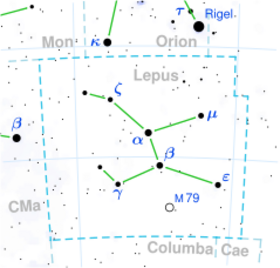Astronomy:Gamma Leporis
| Observation data Equinox J2000.0]] (ICRS) | |
|---|---|
| Constellation | Lepus |
| Right ascension | 05h 44m 27.79089s[1] |
| Declination | −22° 26′ 54.1808″[2] |
| Apparent magnitude (V) | 3.587[3] |
| Characteristics | |
| Spectral type | F6 V[4] |
| U−B color index | −0.007[3] |
| B−V color index | +0.494[3] |
| Astrometry | |
| Radial velocity (Rv) | −9.7[5] km/s |
| Proper motion (μ) | RA: −291.67[2] mas/yr Dec.: −368.97[2] mas/yr |
| Parallax (π) | 112.02 ± 0.18[2] mas |
| Distance | 29.12 ± 0.05 ly (8.93 ± 0.01 pc) |
| Absolute magnitude (MV) | 3.84[6] |
| Details | |
| Mass | 1.23±0.05[7] M☉ |
| Radius | 1.33±0.04[7] R☉ |
| Luminosity (bolometric) | 2.291[8] L☉ |
| Surface gravity (log g) | 4.10[9] cgs |
| Temperature | 6,299[9] K |
| Metallicity [Fe/H] | −0.12[9] dex |
| Rotation | 5.91±0.66[8] |
| Rotational velocity (v sin i) | 15[10] km/s |
| Age | 1.3[6] Gyr |
| Other designations | |
| Database references | |
| SIMBAD | data |
Gamma Leporis, Latinized from γ Leporis, is a star in the south central part of the constellation Lepus, southeast of Beta Leporis and southwest of Delta Leporis. With an apparent visual magnitude of 3.587,[3] it is bright enough to be seen with the naked eye. Based upon an annual parallax shift of 112.02 mas as seen from Earth, its distance can be estimated as 29 light years from the Sun. It has a common proper motion companion, AK Leporis, which is a variable star of the BY Draconis type and has an average brightness of magnitude 6.28.[12] The two are 95″ apart can be well seen in binoculars.[11] Gamma Leporis is a member of the Ursa Major Moving Group.[7]
Gamma Leporis is an F-type main-sequence star with a stellar classification of F6 V.[4] It is larger than the Sun with 1.2 times the radius of the Sun and 1.3 times the Sun's mass.[7] The star is around 1.3 billion years old[6] and is spinning with a rotation period of about six days.[8] Based upon its stellar characteristics and distance from Earth, Gamma Leporis was considered a high-priority target for NASA's Terrestrial Planet Finder mission. It has been examined for an infrared excess, but none has been observed.[8]
See also
References
- ↑ van Leeuwen, F. (November 2007), "Validation of the new Hipparcos reduction", Astronomy and Astrophysics 474 (2): 653–664, doi:10.1051/0004-6361:20078357, Bibcode: 2007A&A...474..653V.
- ↑ 2.0 2.1 2.2 2.3 Perryman, M. A. C. (1997). "The Hipparcos Catalogue". Astronomy and Astrophysics 323: L49–L52. Bibcode: 1997A&A...323L..49P.
- ↑ 3.0 3.1 3.2 3.3 Gutierrez-Moreno, A. (1966). "A system of photometric standards". Publicaciones del Departamento de Astronomia de la Universidadde Chile 1: 1. Bibcode: 1966PDAUC...1....1G.
- ↑ 4.0 4.1 Montes, D. et al. (November 2001). "Late-type members of young stellar kinematic groups - I. Single stars". Monthly Notices of the Royal Astronomical Society 328 (1): 45–63. doi:10.1046/j.1365-8711.2001.04781.x. Bibcode: 2001MNRAS.328...45M.
- ↑ Evans, D. S. (June 20–24, 1966). "The Revision of the General Catalogue of Radial Velocities". University of Toronto: International Astronomical Union. Bibcode: 1967IAUS...30...57E.
- ↑ 6.0 6.1 6.2 Holmberg, J.; Nordström, B.; Andersen, J. (July 2009). "The Geneva-Copenhagen survey of the solar neighbourhood. III. Improved distances, ages, and kinematics". Astronomy and Astrophysics Supplement Series 501 (3): 941–947. doi:10.1051/0004-6361/200811191. Bibcode: 2009A&A...501..941H. Note: see VizieR catalogue V/130.
- ↑ 7.0 7.1 7.2 7.3 Ammler-von Eiff, M.; Guenther, E. W. (October 2009). "Spectroscopic properties of cool Ursa Major group members". Astronomy & Astrophysics 508 (2): 677–693. doi:10.1051/0004-6361/200912660. Bibcode: 2009A&A...508..677A.
- ↑ 8.0 8.1 8.2 8.3 Montesinos, B. et al. (September 2016), "Incidence of debris discs around FGK stars in the solar neighbourhood", Astronomy & Astrophysics 593: 31, doi:10.1051/0004-6361/201628329, A51, Bibcode: 2016A&A...593A..51M.
- ↑ 9.0 9.1 9.2 Gratton, R. G.; Carretta, E.; Castelli, F. (October 1996). "Abundances of light elements in metal-poor stars. I. Atmospheric parameters and a new T_eff_ scale". Astronomy and Astrophysics 314: 191–203. Bibcode: 1996A&A...314..191G.
- ↑ Bernacca, P. L.; Perinotto, M. (1970). "A catalogue of stellar rotational velocities". Contributi Osservatorio Astronomico di Padova in Asiago 239 (1): 1. Bibcode: 1970CoAsi.239....1B.
- ↑ 11.0 11.1 "LTT 2364 -- High proper-motion Star". SIMBAD. Centre de Données astronomiques de Strasbourg. http://simbad.u-strasbg.fr/simbad/sim-basic?Ident=LTT+2364.
- ↑ STERNBILD HASE, http://pegasus-wolfenbuettel.de/phocadownload/SB_Hase.pdf, retrieved 2022-01-19
External links
 |


